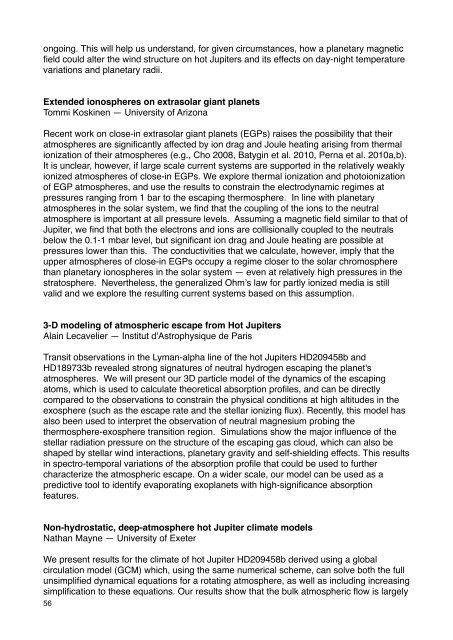Exoclimes_Conference_booklet1
Exoclimes_Conference_booklet1
Exoclimes_Conference_booklet1
You also want an ePaper? Increase the reach of your titles
YUMPU automatically turns print PDFs into web optimized ePapers that Google loves.
ongoing. This will help us understand, for given circumstances, how a planetary magnetic<br />
field could alter the wind structure on hot Jupiters and its effects on day-night temperature<br />
variations and planetary radii.<br />
Extended ionospheres on extrasolar giant planets!<br />
Tommi! Koskinen — University of Arizona<br />
Recent work on close-in extrasolar giant planets (EGPs) raises the possibility that their<br />
atmospheres are significantly affected by ion drag and Joule heating arising from thermal<br />
ionization of their atmospheres (e.g., Cho 2008, Batygin et al. 2010, Perna et al. 2010a,b).<br />
It is unclear, however, if large scale current systems are supported in the relatively weakly<br />
ionized atmospheres of close-in EGPs. We explore thermal ionization and photoionization<br />
of EGP atmospheres, and use the results to constrain the electrodynamic regimes at<br />
pressures ranging from 1 bar to the escaping thermosphere. In line with planetary<br />
atmospheres in the solar system, we find that the coupling of the ions to the neutral<br />
atmosphere is important at all pressure levels. Assuming a magnetic field similar to that of<br />
Jupiter, we find that both the electrons and ions are collisionally coupled to the neutrals<br />
below the 0.1-1 mbar level, but significant ion drag and Joule heating are possible at<br />
pressures lower than this. The conductivities that we calculate, however, imply that the<br />
upper atmospheres of close-in EGPs occupy a regime closer to the solar chromosphere<br />
than planetary ionospheres in the solar system — even at relatively high pressures in the<br />
stratosphere. Nevertheless, the generalized Ohm’s law for partly ionized media is still<br />
valid and we explore the resulting current systems based on this assumption.<br />
3-D modeling of atmospheric escape from Hot Jupiters !<br />
Alain Lecavelier — Institut d'Astrophysique de Paris!<br />
Transit observations in the Lyman-alpha line of the hot Jupiters HD209458b and<br />
HD189733b revealed strong signatures of neutral hydrogen escaping the planet's<br />
atmospheres. We will present our 3D particle model of the dynamics of the escaping<br />
atoms, which is used to calculate theoretical absorption profiles, and can be directly<br />
compared to the observations to constrain the physical conditions at high altitudes in the<br />
exosphere (such as the escape rate and the stellar ionizing flux). Recently, this model has<br />
also been used to interpret the observation of neutral magnesium probing the<br />
thermosphere-exosphere transition region. Simulations show the major influence of the<br />
stellar radiation pressure on the structure of the escaping gas cloud, which can also be<br />
shaped by stellar wind interactions, planetary gravity and self-shielding effects. This results<br />
in spectro-temporal variations of the absorption profile that could be used to further<br />
characterize the atmospheric escape. On a wider scale, our model can be used as a<br />
predictive tool to identify evaporating exoplanets with high-significance absorption<br />
features.<br />
Non-hydrostatic, deep-atmosphere hot Jupiter climate models<br />
Nathan Mayne — University of Exeter!<br />
We present results for the climate of hot Jupiter HD209458b derived using a global<br />
circulation model (GCM) which, using the same numerical scheme, can solve both the full<br />
unsimplified dynamical equations for a rotating atmosphere, as well as including increasing<br />
simplification to these equations. Our results show that the bulk atmospheric flow is largely<br />
56


